The SK Hynix Gold S31 SATA SSD Review: Hynix 3D NAND Finally Shows Up
by Billy Tallis on November 13, 2019 12:00 PM ESTAnandTech Storage Bench - Light
Our Light storage test has relatively more sequential accesses and lower queue depths than The Destroyer or the Heavy test, and it's by far the shortest test overall. It's based largely on applications that aren't highly dependent on storage performance, so this is a test more of application launch times and file load times. This test can be seen as the sum of all the little delays in daily usage, but with the idle times trimmed to 25ms it takes less than half an hour to run. Details of the Light test can be found here. As with the ATSB Heavy test, this test is run with the drive both freshly erased and empty, and after filling the drive with sequential writes.
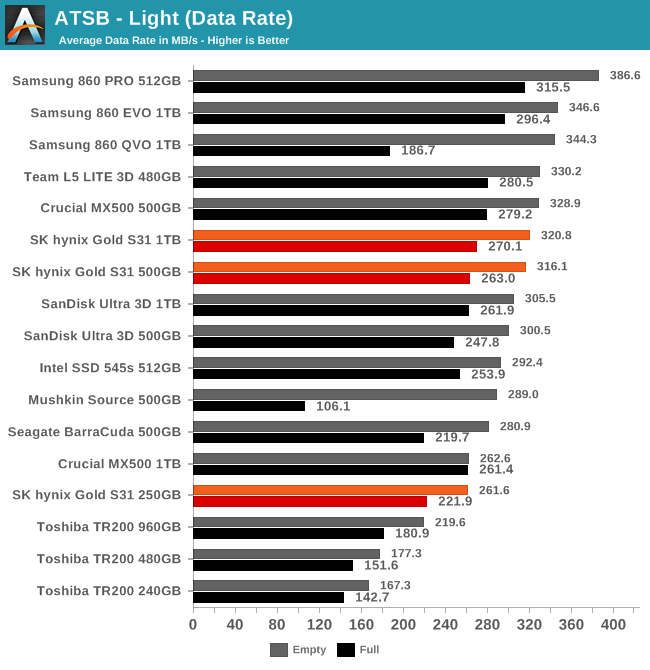
On the Light test, the SK Hynix Gold S31 SSDs all show decent overall performance, including when the test is run on a full drive. They aren't the fastest SATA drives to complete the test, but they trail by single-digit percentages.
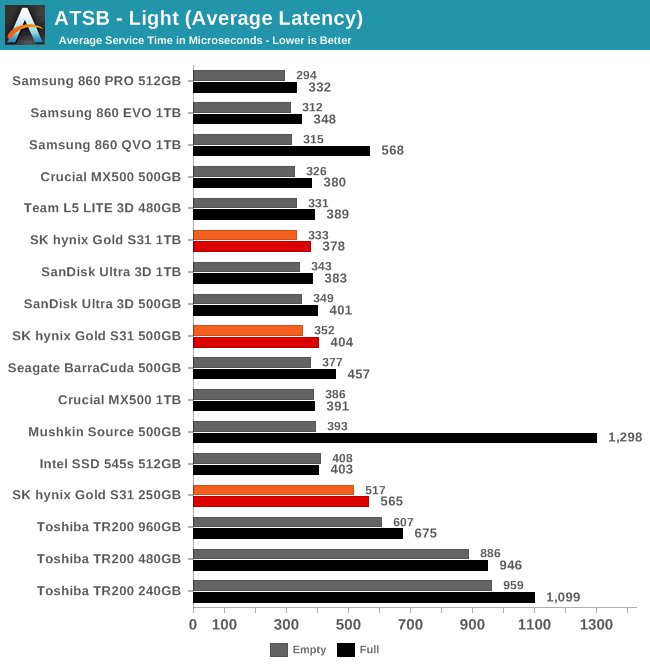
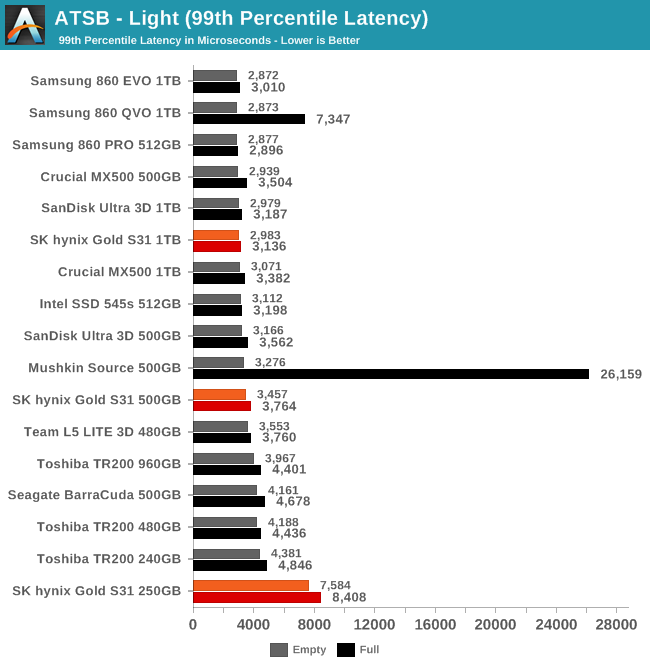
Average and 99th percentile latency is great for the larger two S31 models. The average latency for the 250GB model is a bit higher than for its larger siblings, but it's still ahead of the DRAMless drives. The 99th percentile latency score for the 250GB S31 is bad news: it's almost twice as bad as the DRAMless SSDs, though thankfully the S31's performance doesn't completely fall to pieces if the test is run on a full drive
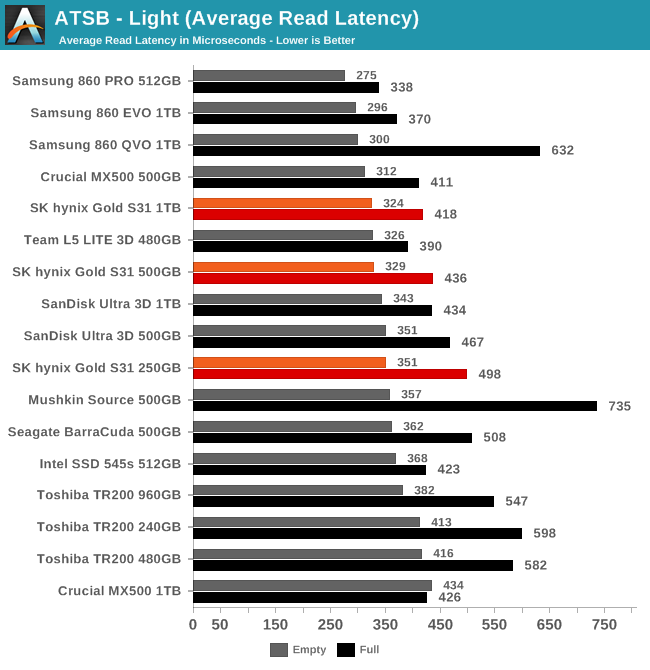
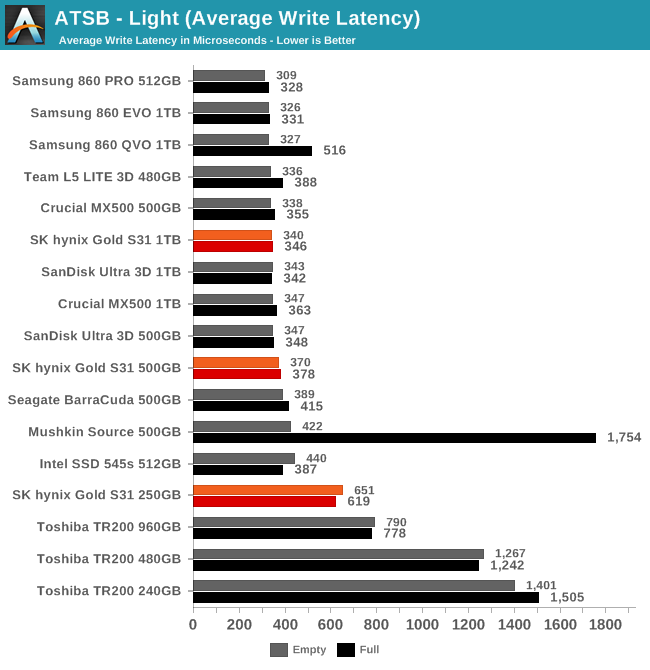
The average read latencies from the S31 drives is unremarkable. For reads, the 250GB model does stick out a bit from this crowd, but it isn't as much of an outlier as the DRAMless models.

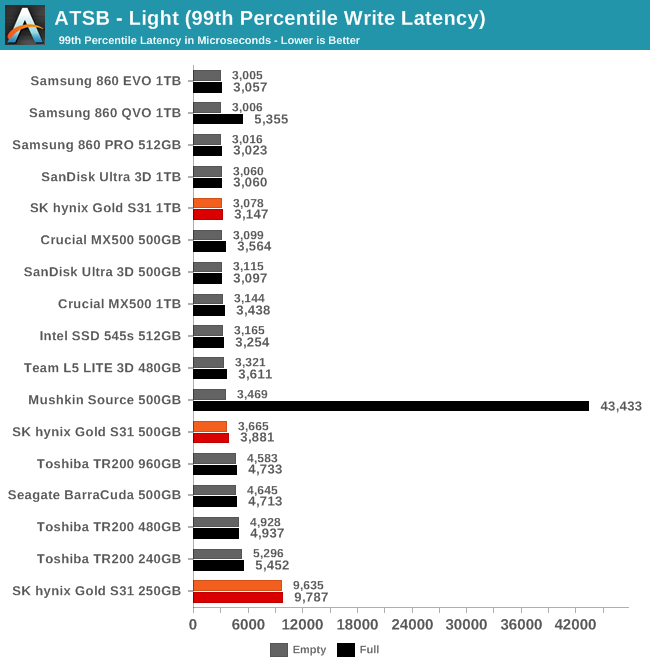
As with average read and write latencies, the 99th percentile latency subscores show that the S31 isn't really a problem for reads, and it is a minor issue for writing to the drive.
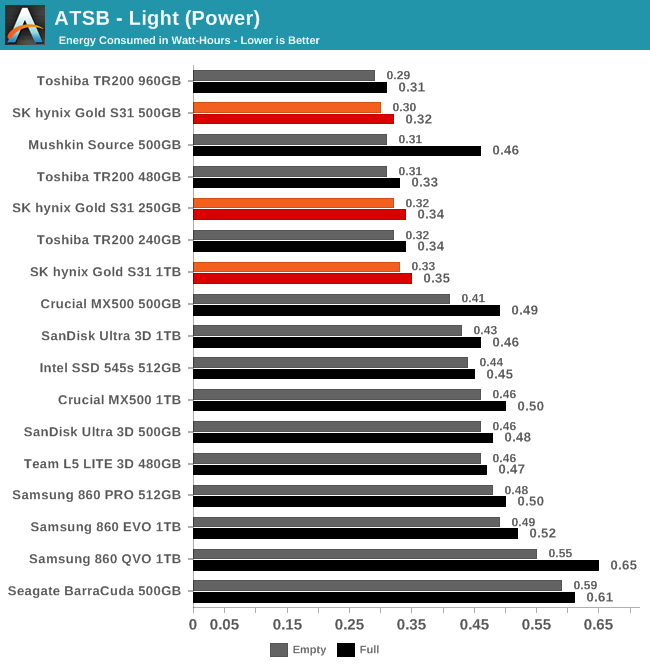
The SK Hynix Gold S31 drives are essentially tied with the DRAMless SSDs for lowest energy usage over the course of the Light test.










22 Comments
View All Comments
MenhirMike - Wednesday, November 13, 2019 - link
We're not going to get under 10c/GB anytime soon, will we? SATA SSDs seem to be stagnant - performance is OK, power consumtion is OK, price is $100 for 1TB, endurance is the usual 0.3 WPD - and yet there are constantly new products with different components and basically the same performance/power/price.Is there a limitation that currently causes stagnation? (I know that SATA is inherently limited in performance, but price shouldn't be stagnant if the main need in that sector is more capacity for less money, with performance/power/endurance being the same)
FunBunny2 - Wednesday, November 13, 2019 - link
"price shouldn't be stagnant if the main need in that sector is more capacity for less money"all of these companies face the Tyranny of Fixed Cost, i.e. the BoM is almost all amortization of the plant and equipment to make the various bits and pieces. sand, some chemicals, and a watchman or two to hover over the machines amount to the variable cost. in such a situation, the only way to lower *average cost* (and shut up the bean counters) is to ship more product and thus spread the fixed cost a tad thinner. lots more product. but that, in turn, is strictly limited by user demand. they're caught between a rock and a hard place. they end up viewing the situation as zero-sum game; one can win only if the other(s) lose when there's little to no global (in every sense of the word) growth. welcome to Earthly Stagnation.
dromoxen - Thursday, November 14, 2019 - link
Having Dr ManHattan looking after your machines is a very expensive business , Rorschach is very unreliable too.eek2121 - Wednesday, November 13, 2019 - link
Except prices have been falling. You just don't realize it because it happens over time.These drives are as cheap as Samsung's QLC drives, without the disadvantages.
Slash3 - Wednesday, November 13, 2019 - link
SSD prices have been basically flat since October/November 2018. Check the price tracking for a 500GB/1TB MX500 or 860 Evo and there have been a few variations but nothing substantial or permanent.I'd love to pick up more large capacity solid state to replace some of my HDDs, but I bought two 2TB SSDs over a year ago and they're actually a few dollars *more* expensive now.
At this point, it may actually be cheaper to build a large NAS using MicroSD cards...
eek2121 - Wednesday, November 13, 2019 - link
I paid the same amount for my 2 TB 970 evo as I did my 1 TB 960 evo 2.5-3 years ago. Also, don't track specific drivers, look at charts. NAND is coming down. It just takes time.Slash3 - Wednesday, November 13, 2019 - link
/s implied with respect to the MicroSD card NAS, if it weren't obvious.Although that would be fun to build.
nandnandnand - Wednesday, November 13, 2019 - link
Sale prices are hitting 8c/GB. Don't pay 10c/GB if you live in America. As the average drive capacity goes up, the prices will continue to go down.Thankfully, 100 GB and larger games are a thing, so that should create some demand.
deil - Thursday, November 14, 2019 - link
we might PLC coming soon, so we might see some 1 TB/1.5 TB/2TB/3TB sata's soon and as they are 20% bigger after amortization wears off, almost 20% cheaper it will become.main focus will go to PCIE4.0 now though. so I would say next December expect 2 or 3 products with same nand. 120GB/240 will not go lower than its is now.
deil - Thursday, November 14, 2019 - link
in there on the article. We already did on 1 TB ones. and PLC will go even lower.ADATA SU800 $34.99
(14¢/GB) $57.99
(11¢/GB) $91.99
(9¢/GB) $209.99
(10¢/GB)